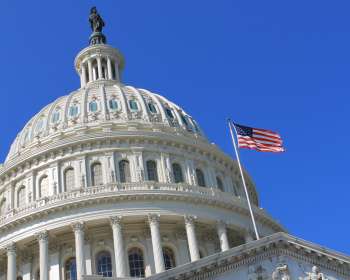Addressing the rapidly evolving space domain demands continuous efforts from government leaders as well as the organizations who support them. Providing the incoming administration with research on the implications of this expansion of space innovation enables informed decision making and future planning. In support of the nation’s leaders, The Aerospace Corporation’s Center for Space Policy and Strategy (CSPS) recently released Space Agenda 2025, a series of papers highlighting the major space challenges facing policymakers in the upcoming years.
“There has been an enormous amount of change in the space enterprise with significant progress in space-based applications,” said Jamie Morin, Vice President of Aerospace and Executive Director of CSPS. “We're using communications technology and remote sensing in ways that were not reality just four years ago. And we're grappling with accelerating climate change that is deeply dependent on space technology for understanding, mitigation and remediation. Space technology is bringing the world together, but also raising new security challenges that are very real and playing out on the world stage.”
Throughout the Space Agenda 2025 papers, CSPS experts discussed their research and its importance for broader space domain themes. In a briefing in public, these experts discussed further the applications of this research, facilitating a better understanding of the three identified pressing challenges facing US leadership, as well as emphasizing an imperative to prepare for the future space enterprise.
“Across national security, civil and commercial space, we spent time finding the most critical themes we need to advance on,” said Kara Cunzeman, Director and Founder of Strategic Foresight for CSPS. “These next four years are going to be crucial for policy makers to ensure we're not only safeguarding US leadership in space, but also charting future value for the American people.”

Strengthening Leadership and Competitiveness
The first critical issue identified by CSPS was Strengthening Leadership and Competitiveness. The rapidly expanding space domain continues to bring new challenges for the US’s ability to manage proliferated space systems, as well as the space-enabled capabilities that emerge from this expansion.

Angie Bukley, Technical Fellow and Senior Scholar in CSPS, discussed the significance of cislunar exploration in the future of US space leadership, emphasizing the need for the US to take lead in guiding safe operations for establishing cislunar infrastructure.
“If we're going to continue our progress for cislunar space utilization then we need to continue to invest in our lunar exploration and exploitation, not only through the Artemis campaigns, but also through the CLPS (Commercial Lunar Payload Services) program, and our national security space missions.” said Bukley.
In addition to the emerging interest in cislunar space, CSPS also discussed the developing attention on Arctic resource competition. Karen Jones, Senior Project Leader in CSPS, shared insight on the global interest in protecting territorial, economic and military interests in the Arctic region and how the US can utilize its space capabilities to strengthen its leadership.
“It is a crucial time for satellite systems to support affordable and persistent connectivity, navigation and observation,” said Jones. “The Arctic has a front row seat for understanding the effects of a warming planet, with the melting sea ice hastening the race for resources.”
Catalyzing Commercial Space
CSPS experts then weighed in on the many opportunities for US space leaders to leverage commercial space and the innovations this partnership brings.
“The Department of Defense has the opportunity to leverage commercial space capabilities and services that offer promising national security and defense applications. They can use compelling services and systems without having to pay the development costs of building those capabilities from scratch,” said Sam Wilson, Systems Director in CSPS. “The dilemma is that these companies now have less private and public investment in their capabilities, which cannot sustain them, and many would not be profitable in the absence of government revenue.”
Wilson discussed the value of commercial space capabilities and the impact they could have in strengthening national security space, as well as US space leadership overall.
Charting Future Value

With the recent rapid growth of commercial space, issues pertaining to oversight, governance and regulation begin to rise to the surface. Growing demands for space capabilities are met with concern for the future of space operations. Ensuring space sustainability, according to Brian Weeden, Systems Director in CSPS, begins with proactive reforms and regulations across US leadership.
“It is critically important for the next US administration to continue efforts to modernize and reform space regulations,” said Weeden. “Without prioritizing and implementing reforms, the US could have consequences in continued growth, the commercial-based sector and the ability of the government to leverage commercial capabilities, all impacting US leadership in space.”
The future of space is not only determined in modernized policy, but also with preventative actions to improve space traffic management and debris mitigation in response to the increased number of space operators.

“The challenge with contested space and a potential conflict is that you can end up suddenly with a lot of hazardous debris,” said Marlon Sorge, Technical Fellow in CSPS and Executive Director of Aerospace’s Center for Orbital and Reentry Studies (CORDS). “Then, the combination of a contested environment along with this congestion, has potential negative consequences in terms of maintaining the sustainability of space. It's critical that the policy makers think ahead to ensure that we've got a structure in place for a robustly sustainable space operating environment.”
Planning for the future space domain requires a comprehensive understanding of the opportunities and issues at stake for US space leadership. With the release of Space Agenda 2025, Aerospace’s CSPS provided its expertise and research to bring focus on the value of space for the future of the nation’s capabilities as well as helping shape recommendations for U.S. space efforts.
To learn more on these topics, visit the Space Agenda 2025 website.
Watch the public briefing on YouTube.

